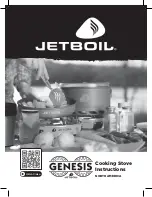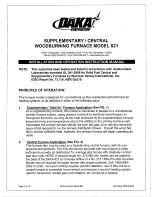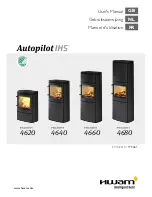
UNPACKING THE STOVE
The stove arrives bolted and strapped to its pallet. There must be
adequate facilities for unloading and manoeuvring into position The
wrapping is first removed, then the stove released from the pallet by
removing 4 pallet bolts using a 10mm spanner. The pallet brackets
can now be removed from the stove by tilting it and using a 13mm
spanner to remove the bolts. These 4 bolts are required for levelling
or fixing on the Store Stand. The Stove may now be moved to its
final position. The pallet is intended to be cut up and used for kindling
fuel.
Please take care when installing the stove that the requirements of
the Health and Safety at Work Act 1974 are met.
The
vent must be positioned such that it is not liable to blockage
HEALTH AND SAFETY PRECAUTIONS
Some types of fire cement are caustic and should not be allowed to
come into contact with the skin. In case of contact wash with plenty
of water.
If there is a possibility of disturbing any asbestos in the course of
installation then please use appropriate protective equipment.
There must not be an extractor fan fitted in the same room as the
stove as this can cause the appliance to emit fumes into the room.
.
Minimium areas are given in the following table:
A fixed ducted air supply may be used as an alternative to the
traditional method of using a permanent open vent into a room to
supply air for combustion.
External air supply kits are available please contact Charnwood for
more information.
This stove is capable of intermittent operation, and is not suitable for
There must be an adequate air supply into the room in which the
appliance is installed to provide combustion air. The combustion air
supply must be via a permanently open vent. The requirement for
minimum free area is partly dependent on the design air permeability
of the house. In older properties the air permeability will be above
5.0m³/(h.m²), but in some modern properties it may be less.
10
®
INSTALLATION INSTRUCTIONS
use in a shared flue system.
In addition to these instructions the requirements of BS.8303 and
BSEN 15287-1:2007 must be fulfilled. Local Authority Bylaws and
Building Regulations, including those referring to national and
European Standards, regarding the installation of Solid Fuel burning
appliances, flues and chimneys must also be observed.
CO ALARMS
Building regulations require that whenever a new or replacement
fixed solid fuel or wood/biomass appliance is installed in a dwelling a
carbon monoxide alarm must be fitted in the same room as the
appliance. Further guidance on the installation of the carbon
monoxide alarm is available in BS EN 50292:2002 and from the
alarm manufacturer's instructions. Provision of an alarm must not be
considered a substitute for either installing the appliance correctly or
ensuring regular servicing and maintenance of the appliance and
chimney system.
The outputs in the table are based on a 45 minute re-fuelling cycle
burning seasoned hardwood logs. All tests are carried out in
accordance with BSEN 13240.
In order for the appliance to perform satisfactorily the chimney height
must not be less than 4 metres measured vertically from the outlet of
the stove to the top of the chimney. The internal dimensions of the
chimney should preferably be 150-200 mm (6"- 8") either square or
round and MUST NOT BE LESS THAN 125 mm (5").
If an existing chimney is to be used it must be swept and checked, it
must be in good condition, free from cracks and blockages, and
SPECIFICATION
CHIMNEY
Air Permeability
m³/(h.m²)
Minimum Vent Area
cm²(in²)
> 5.0
No
Requirement
<5.0
27.5 (4.3)
Specification
Nominal Heat Output
kW (BTU/hr)
5.0
(17,000)
Stove Weight kg
(Packed)
96
Flue Temperature °C
247
Minimum
Flue Draught
12Pa
Flue gas Mass Flow g/s
4.2
Hearth Temperature °C
69.9
Minimum distance from
combustibles mm
500 side
400 rear
Содержание bembridge
Страница 1: ...Operating Installation Instructions ...
Страница 2: ......
Страница 17: ......
Страница 18: ......





































